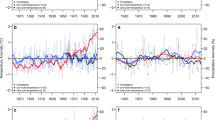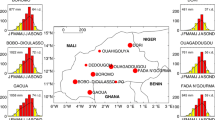Abstract
This paper analyzes the spatial dependence of annual diurnal temperature range (DTR) trends from 1950–2004 on the annual climatology of three variables: precipitation, cloud cover, and leaf area index (LAI), by classifying the global land into various climatic regions based on the climatological annual precipitation. The regional average trends for annual minimum temperature (T min) and DTR exhibit significant spatial correlations with the climatological values of these three variables, while such correlation for annual maximum temperature (T max) is very weak. In general, the magnitude of the downward trend of DTR and the warming trend of T min decreases with increasing precipitation amount, cloud cover, and LAI, i.e., with stronger DTR decreasing trends over drier regions. Such spatial dependence of T min and DTR trends on the climatological precipitation possibly reflects large-scale effects of increased global greenhouse gases and aerosols (and associated changes in cloudiness, soil moisture, and water vapor) during the later half of the twentieth century.










Similar content being viewed by others
References
Chen M, Xie P, Janowiak JE, Arkin PA (2001) Global land precipitation: a 50-year monthly analysis based on gauge observations. J Hydrom 3:249–266
Collatz GJ, Bounoua L, Los SO, Randall DA, Fung IY, Sellers PJ (2000) A mechanism for the influence of vegetation on the response of the diurnal temperature range to changing climate. Geophy Res Lett 27:3381–3384
Dai A, Del Genio AD, Fung IY (1997) Clouds, precipitation, and temperature range. Nature 386:665–666
Dai A, Trenberth KE, Karl TR (1999) Effects of clouds, soil moisture, precipitation, and water vapor on diurnal temperature range. J Clim 12:2451:2473
Dai A, Karl TR, Sun B, Trenberth KE (2006) Recent trends in cloudiness over the United States: a tale of monitoring inadequacies. Bull Am Met Soc 87(5):597–606
Easterling DR et al (1997) Maximum and minimum temperature trends for the globe. Science 277:364–367
Friedl MA et al (2002) Global land cover from MODIS: algorithms and early results. Remote Sens Environ 83:287–302
Granger CWJ, Newbold P (1974) Spurious regressions in econometrics. J Econom 2:111–120
Gujarati DN (1995) Basic econometrics, 3rd edn. McGraw-Hill, New York. ISBN 0-07-025214-9
Hansen J, Sato M, Ruedy R (1995) Long-term changes of the diurnal temperature cycle: implications about mechanisms of global climate change. Atmos Res 37:175–209
Huang Y, Dickinson RE, Chameides WL (2006) Impact of aerosol indirect effect on surface temperature over East Asia. Proc Natl Acad Sci USA 103:4371–4376
IPCC (2001) Climate change 2001: the scientific basis. Cambridge University Press, Cambridge
IPCC (2007) Climate change 2007: the physical science basis, contribution of working group I to the fourth assessment report of the IPCC (ISBN 978 0521 88009-1), Cambridge University Press, Cambridge
Jones PD, Moberg A (2003) Hemispheric and land-scale surface air temperature variations: an extensive revision and an update to 2001. J Clim 16:206–223
Kaiser DP (1998) Analysis of total cloud amount over China. Geophys Res Lett 25(19):3599–3602
Karl T et al (1993) A new perspective on recent global warming: asymmetric trends of daily maximum and minimum temperature. Bull Am Meteorol Soc 74(6):1007–1023
Madden RA, Williams J (1978) The correlation between temperature and precipitation in the United States and Europe. Mon Weather Rev 106:142–147
Menne MJ, Williams CW Jr (2005) Detection of undocumented change point: on the use of multiple test statistics and composite reference series. J Clim 18(20):4271–4286
Mitchell JFB, Davis RA, Ingram WJ, Senior CA (1995) On surface temperature, greenhouse gases, and aerosols: models and observations. J Clim 8:2364–2386
Mitchell KE et al (2004) The multi-institution North American Land Data Assimilation System (NLDAS): utilizing multiple GCIP products and partners in a continental distributed hydrological modeling system. J Geophys Res 109:D07S90. doi:10.1029/2003JD003823
Myneni RB et al (2002) Global products of vegetation leaf area and fraction absorbed PAR from year one of MODIS data. Remote Sens Environ 83:214–231
New M, Lister D, Hulme M, Makin I (2002) A high-resolution data set of surface climate for terrestrial land areas. Clim Res 21:1–25
Nicholls N (2004) The changing nature of Australian droughts. Clim Change 63:323–336
Peterson TC, Vose RS, Razuvaey VN, Schmoyer RL (1998) Global Historical Climatology Network (GHCN) quality control of monthly temperature data. Int J Climatol 18:1169–1179
Qian T, Dai A, Trenberth KE, Oleson KW (2006) Simulation of global land surface conditions from 1948–2004. Part I: forcing data and evaluation. J Hydrom 7:953–975
Stenchikov GL, Robock A (1995) Diurnal asymmetry of climatic response to increased CO2 and aerosols: forcings and feedbacks. J Geophys Res 100:26211–26227
Stone DA, Weaver AJ (2003) Factors contributing to diurnal temperature range trends in twentieth and twenty-first century simulations of the CCCma coupled model. Clim Dyn 20:435–445
Trenberth KE, Shea DJ (2005) Relationships between precipitation and surface temperature. Geophys Res Lett 32:L14703. doi:10.1029/2005GL022760
Trenberth KE et al (2007) Observations: surface and atmospheric climate change. In: Solomon S, Qin D, Manning M, Chen Z, Marquis M, Averyt KB, Tignor M, Miller HL (eds) Climate change 2007: the physical science basis. Contribution of working group I to the fourth assessment report of the intergovernmental panel on climate change. Cambridge University Press, Cambridge
Vose RS, Easterling DR, Gleason B (2005) Maximum and minimum temperature trends for the globe: an update through 2004. Geophys Res Lett 32:L23822. doi:10.1029/2005GL024379
Zhou L et al (2003) A sensitivity study of climate and energy balance simulations with use of satellite derived emissivity data over the northern Africa and the Arabian peninsula. J Geophys Res 108(D24):4795. doi:10.1029/2003JD004083
Zhou L et al (2004) Evidence for a significant urbanization effect on climate in China. Proc Natl Acad Sci USA 101(26):9540–9544
Zhou L, Dickinson RE, Tian Y, Vose R, Dai Y (2007) Impact of vegetation removal and soil aridation on diurnal temperature range in a semiarid region—application to the Sahel. Proc Natl Acad Sci USA 104(46):17937–17942
Acknowledgments
The authors wish to thank two anonymous reviewers for suggestions that improved the manuscript. This study was supported by the NSF grant ATM-0720619 and the DOE grant DE-FG02-01ER63198. H. Chen was supported by the National Natural Science Foundation of China under grant 40405018 and the Foundation of Jiangsu Key Laboratory of Meteorological Disaster (KLME050205), NUIST, China. Y. Dai was supported by the National Natural Science Foundation of China under grant 40225013 and the 111 Project of Ministry of Education and State Administration for Foreign Experts Affairs of China. The National Center for Atmospheric Research is supported by the National Science Foundation.
Author information
Authors and Affiliations
Corresponding author
Additional information
An erratum to this article can be found at http://dx.doi.org/10.1007/s00382-008-0393-7
Rights and permissions
About this article
Cite this article
Zhou, L., Dai, A., Dai, Y. et al. Spatial dependence of diurnal temperature range trends on precipitation from 1950 to 2004. Clim Dyn 32, 429–440 (2009). https://doi.org/10.1007/s00382-008-0387-5
Received:
Accepted:
Published:
Issue Date:
DOI: https://doi.org/10.1007/s00382-008-0387-5




